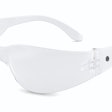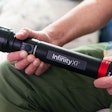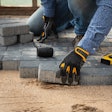
The U.S. Bureau of Labor Statistics indicates there were 68,170 occupational nonfatal head injuries in 2020.
A hard hat is a primary piece of Personal Protective Equipment (PPE) serving to help prevent potential injuries. In addition to a standard hard hat, another option is a full brim hard hat. An investment in a full brim hard hat yields many returns in comfort, safety and productivity.
According to the Occupational Safety & Health Administration (OSHA) Section 1926.100 for head protection, “employees working in areas where there is a possible danger of head injury from impact, or from falling or flying objects, or from electrical shock and burns, shall be protected by protective helmets.”
A full brim hard hat provides greater protection in contrast to a standard hard hat in that it is designed with a wide brim extending around the circumference of the head – including the sides and the back. As such, it provides protection for the face, neck and ears from UV rays and weather elements such as rain as well as risk of injury from falling objects.
Materials and Features
OSHA ‘approved’ hard hats meet the minimum criteria established by the American National Standards (ANSI) and the International Safety Equipment Association’s ANSI/ISEA Z89.1-standards.
Full brim hard hats are typically made from high-density polyethylene (HDPE) or thermoplastic materials, which make them durable and lightweight, though some features may make the hats less lightweight.
Some full brim hard hats may come with a suspension system inside the shell to help absorb and dissipate impact while keeping a clearance between the head and shell of the hat. It also results in a more comfortable fit.
Customizable headbands are a feature offered on some full brim hard hats in order to comfortably accommodate different head sizes. Liners and sweatbands add more warmth or cooling.
Another design feature that may be found in full brim hard hats and provide more comfort is an adjustable chin strap, ideal for holding the hat in place in work environments of high risk or extreme weather events, such as a windy day.
Ventilation slots or channels are designed in some full brim hats. The ventilation slots allow for a better flow of air and reduce heat buildup for improved comfort over an extended wear time.
Some full brim hats also may feature accessory slots on the side and front to which additional PPE such as face shields, ear muffs and safety goggles can be attached.
Other typical features of a full brim hard hat include basic and high visibility colors. Reflective elements may be another feature included on some full brim hats, which amplifies the visibility and safety of the worker wearing the hat.
As with standard hard hats, full brim hard hats are available in different types and classes. The type indicates the designated level of impact protection. The class indicates the degree of electrical performance. The class of hat is usually indicated inside the hat shell.
Types of Full Brim Hard Hats
- Type 1, Class E general purpose full-brim hard hats are non-vented and designed to reduce head exposure to high voltage conductors up to 20,000 volts (phase to ground). They also provide protection from vertical impacts.
- Type 1, Class C full brim hats are vented to help dissipate heat. As the vents on Class C hard hats allow a clear path for electrical arcing, they should not be used in locations where electrical hazards are present.
- Type 1, Class G full brim hats are made of heat-resistant material. They are designed to reduce exposure to low voltage conductors, offering phase to ground dielectric protection to the head up to 2,200 volts.
- Type 2, Class E side- and top-protecting full-brim hard hats are used where swinging objects such as hooks and chains pose a hazard. They provide protection against vertical and angled impacts up to 60 degrees. They have more padding than Type 1 hard hat. They are rated Class E for high-voltage electrical protection up to 20,000 volts.
Maintenance and Care
Inspect full brim hats on a regular basis for damage and replace the shell or other parts when they become damaged. Cleaning solvents may damage the shell. To clean hats, dip them in hot water with detergent, scrub the shell and rinse in clear hot water.















